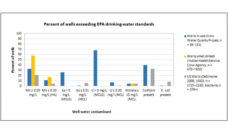Arsenic is a highly toxic heavy metal found in rocks, soil, plants, and water. Since arsenic naturally occurs in aquifers, it is often found in groundwater across the United States.
Low to moderate arsenic exposure is associated with cardiovascular disease, diabetes, and cancer, but it is particularly concerning for newborn and early childhood development, where it may result in cognitive and developmental damage. In addition, repeated exposure to even small traces can be dangerous over time.
The Safe Drinking Water Act, introduced in 1996 by the Environmental Protection Agency (EPA), sets regulations for arsenic concentrations in public water supplies. However, these regulations do not extend to the 14% of American households that rely on private wells or other groundwater sources. Most of these residents live in rural areas and must monitor the well water themselves to ensure their water is safe to drink.
Since many American Indian communities are centered in rural areas, they are at high risk for exposure to dangerous traces of arsenic, with 26% of private wells holding increased levels of arsenic. The Strong Heart Water Study (SHWS) is a randomized controlled trial meant to compare interventions designed to reduce arsenic exposure among tribal communities in the Northern Great Plains area. This study offers a community-led approach involving the Tribal Housing Authority implementing an arsenic intervention among its communities.
Since the study was designed in collaboration with community members and the Tribal Housing Authority, the program’s long-term sustainability is ensured due to the local partners’ ownership of the program.
Participants assigned to one intervention group received point-of-use (POU) filters installed in households’ kitchen sinks, as well as three phone calls after installation to promote filter use. The second group received a filter and 3 phone calls, as well, but they also received additional support, including home visits and educational videos to promote the use of the filter for all cooking and drinking needs.
Researcher Tracy Zacher and her colleagues evaluated the efficacy of the arsenic filters provided by the SHWS to determine if extra support measures affected filter use. The researchers also examined water concentrations of arsenic in filtered and unfiltered water over time.
Ninety-three percent of the filters reduced arsenic levels to the safety standard set by the EPA. While fewer than half of the participants did not change their filter at the recommended 12-month point, most of the filters continued to work throughout the study period. The researchers concluded that the arsenic filters installed by the Strong Heart Water Study program effectively reduced arsenic concentration in these communities. There were no differences observed between the two study arms, indicating that extra behavioral support may not be needed to guarantee the success of the filter. Finally, the researchers noted that there was no significant differences in arsenic concentration over time, meaning that multiple testings are unnecessary once filters are in place.
Since the study was designed in collaboration with community members and the Tribal Housing Authority, the program’s long-term sustainability is ensured due to the local partners’ ownership of the program. Zacher recommends that future studies be conducted to evaluate the effectiveness of arsenic filters over a more extended time period and in other global settings.
Photo via Getty Images














